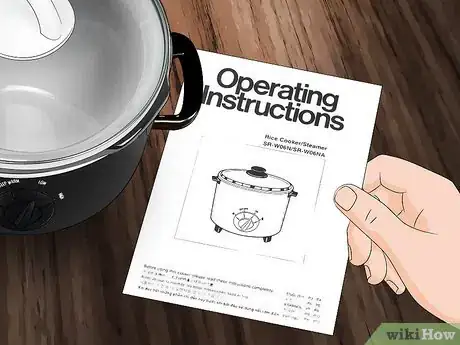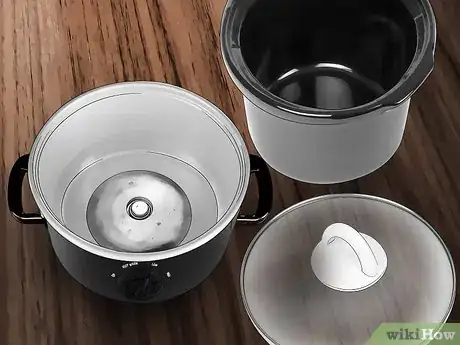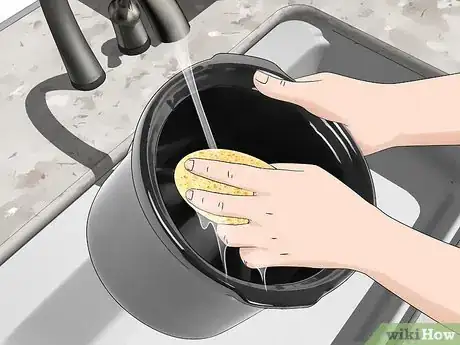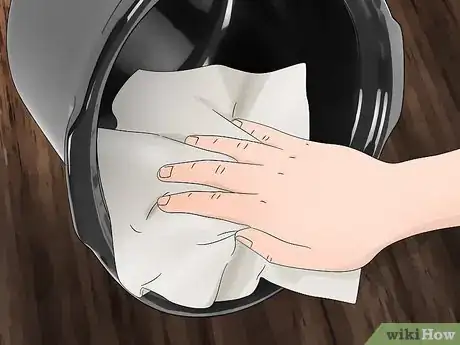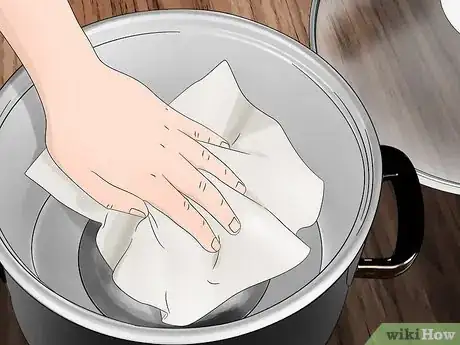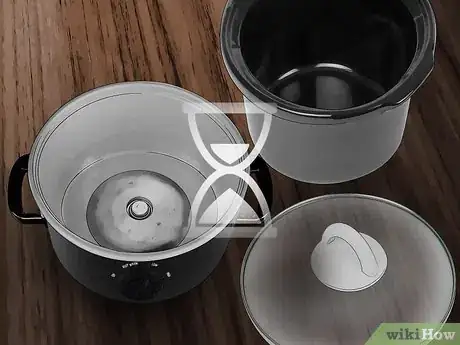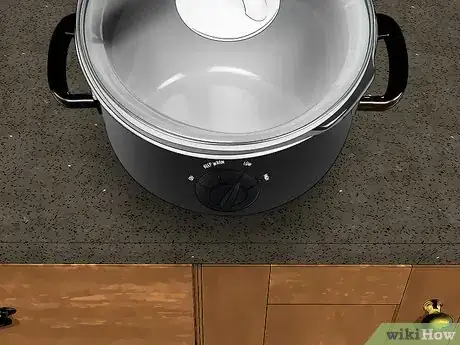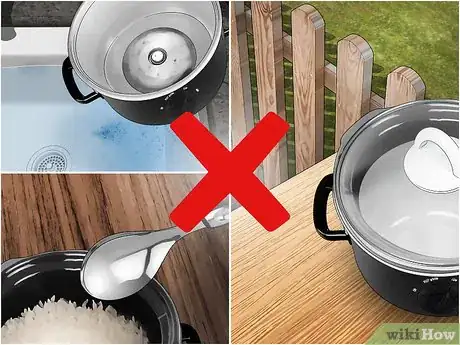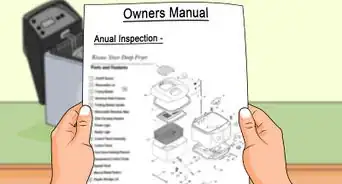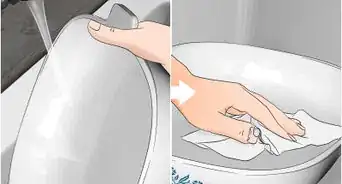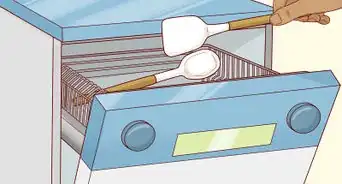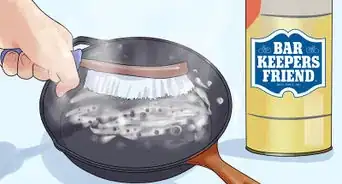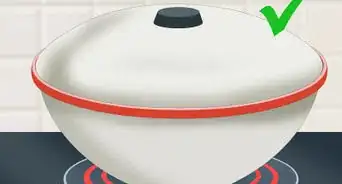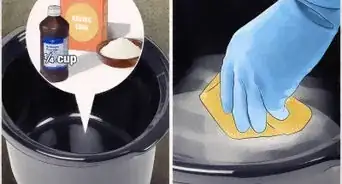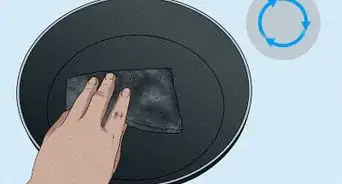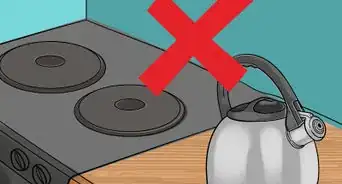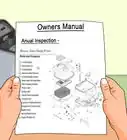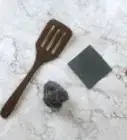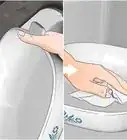This article was co-authored by Alessandra Mendes. Alessandra Mendes is a Cleaning Specialist and the Founder of Cleaning Glow. With ten years of experience, Alessandra and her team specialize in providing residential cleaning services in the San Francisco Bay Area. All members of the Cleaning Glow team have completed thorough background checks.
This article has been viewed 38,045 times.
Clean your rice cooker after every use to prevent stuck-on food and hard-to-remove stains. Unplug and disassemble your cooker to clean the parts individually. Removable parts – such as inner pots and detachable lids – are usually dishwasher-safe, or can be hand washed with a mild detergent. Make sure all components are completely dry before plugging in or storing your cooker.
Steps
Cleaning the Removable Parts
-
1Try to locate your product’s instructions. If you don’t have the original instruction manual, look on your appliance for a model number and brand name. You may be able to locate the instructions online at the brand’s website, such as on a “Help” or “Support” page. Make sure to read and follow all directions and safety precautions.
- Different brands and models of rice cookers have different instructions for cleaning and maintenance.
-
2Unplug the appliance and allow it to cool completely. Take off the lid. Let the appliance cool for 30 minutes to an hour. Consult with the product manual, if you have it, about how long the cooker takes to cool down.[1]Advertisement
-
3Disassemble removable parts to clean them. Remove the inner pot and utensils. Remove the lid, if it’s detachable. Wash any removable parts that don’t have electric components.[2]
- Your cooker may have various removable and washable parts, for instance a steamer tray, condensation collector, ladle, and measuring cup.
- Removable parts are usually dishwasher-safe. Alternately, you can hand wash them.
-
4Wash the inner pot. Soak the pot first, if needed. Unless the instructions state otherwise, you can usually wash inner pots in the dishwasher like other dishes. Alternately, scrub the pot with soap, hot water, and a sponge or brush. Use the sponge to wipe off any pieces of food.[3]
- If any stubborn food particles are stuck, gently use a plastic spoon or spatula to remove them.[4]
-
5Dry all parts before reuse or storage. Use a dry towel to wipe all the parts you washed. If moisture remains, leave them on a dish drying rack. Let all of the parts fully dry before reassembling your cooker.[5]
Cleaning the Cooker
-
1Unplug the appliance and allow it to cool completely. Let the appliance cool – with the lid open – for 30 minutes to an hour. Consult with the product manual, if you have it, about how long the cooker takes to cool down.[6]
-
2Clean the lid. If the lid is detachable, you can wash it alone with soap, hot water, and a sponge or brush, or in the dishwasher with other dishes (unless the instructions state otherwise). If it isn’t detachable, soak a sponge in hot, soapy water. Wipe the lid with the sponge. Rinse the lid carefully with a cloth, so that water doesn’t leak into the cooker.[7]
-
3Clean the inside of the cooker. Wipe off any residue with a moist cloth. If there is residue on the hot plate that’s difficult to remove, you can use sandpaper or fine mesh steel wool on the residue only. Be extremely careful not to scratch your rice cooker. Once the residue is loosened, you can wipe it off with a moist rag. Allow the cooker to dry completely before putting the inner pot back.[8]
- Don’t use abrasive cleaners.
- Cleaning the heating element of your cooker helps to prevent your cooker from boiling over.[9]
-
4Clean the exterior of the cooker, as needed. Use a moist rag to gently wipe down the outside of the cooker if it has stains or residue. If you decide to use a cleaning solution, spray it onto a rag, not directly onto the cooker. Don’t allow any cleaning solution to get inside the cooker.[10]
- If necessary, you can wipe the unplugged cord very gently with a moist cloth.
- If any cleaning solution gets inside the cooker, wipe it up right away.
-
5Dry the cooker before reuse or storage. Use a dry towel to wipe the interior and exterior of the cooker, wherever you applied moisture. Make sure the cooker is completely dry.[11]
Maintaining a Clean Rice Cooker
-
1Clean your rice cooker after every use. After using your rice cooker, take off the lid and allow the whole cooker to cool down completely. Then clean the cooker and wipe off any excess moisture before putting it away.[12]
- If bits of food stay on the hot plate until the next use, they will become baked on and may damage the cooker.
-
2Use your rice cooker on a flat and stable surface. This will help prevent food from cooking unevenly and potentially burning, which can cause it to stick to the bottom of your inner pot.
- For example, use your rice cooker on a counter or sturdy tabletop. Ensure that the cord doesn’t drape over the edge or touch any hot surfaces.
-
3Handle your cooker with care. Never immerse your cooker in water. Keep the cooker unplugged when it’s not in use or not yet ready to cook. Avoid using your rice cooker outdoors, and avoid using metal utensils in your cooker.[13]
- Keep your rice cooker plugged in, on warm mode, if there is cooked rice in it, since the cooker should maintain a proper environment for moist, cooked food.[14]
Expert Q&A
-
QuestionHow do I clean and sanitize my rice cooker?
 Alessandra MendesAlessandra Mendes is a Cleaning Specialist and the Founder of Cleaning Glow. With ten years of experience, Alessandra and her team specialize in providing residential cleaning services in the San Francisco Bay Area. All members of the Cleaning Glow team have completed thorough background checks.
Alessandra MendesAlessandra Mendes is a Cleaning Specialist and the Founder of Cleaning Glow. With ten years of experience, Alessandra and her team specialize in providing residential cleaning services in the San Francisco Bay Area. All members of the Cleaning Glow team have completed thorough background checks.
Cleaning Specialist Thankfully, the rice cooker will sanitize itself with heat, so you only need to worry about removing any stuck-on rice. You can generally do this with a moist cloth once the cooker is unplugged and cool. Of course, you can wash the removable parts if you'd like.
Thankfully, the rice cooker will sanitize itself with heat, so you only need to worry about removing any stuck-on rice. You can generally do this with a moist cloth once the cooker is unplugged and cool. Of course, you can wash the removable parts if you'd like.
Warnings
- Never expose any electrical parts to water.[15]⧼thumbs_response⧽
- Make sure your cooker and all its parts are completely dry before plugging your cooker into a power source.⧼thumbs_response⧽
References
- ↑ http://www.pressurecookerportal.com/clean-rice-cooker/
- ↑ https://learn.compactappliance.com/clean-rice-cooker/
- ↑ http://www.pressurecookerportal.com/clean-rice-cooker/
- ↑ https://learn.compactappliance.com/clean-rice-cooker/
- ↑ http://www.pressurecookerportal.com/clean-rice-cooker/
- ↑ http://www.pressurecookerportal.com/clean-rice-cooker/
- ↑ https://learn.compactappliance.com/clean-rice-cooker/
- ↑ https://learn.compactappliance.com/clean-rice-cooker/
- ↑ http://justhungry.com/how-take-care-your-rice-cooker-video
- ↑ https://learn.compactappliance.com/clean-rice-cooker/
- ↑ http://www.pressurecookerportal.com/clean-rice-cooker/
- ↑ https://learn.compactappliance.com/clean-rice-cooker/
- ↑ http://www.foogod.com/~alex/sushi/ricecooker.html
- ↑ http://www.foogod.com/~alex/sushi/ricecooker.html
- ↑ https://learn.compactappliance.com/clean-rice-cooker/
